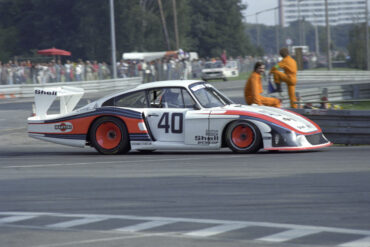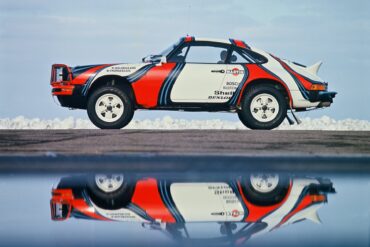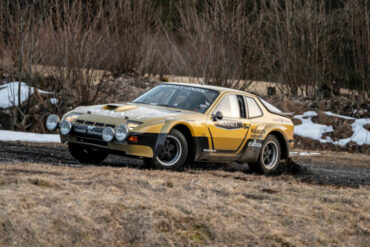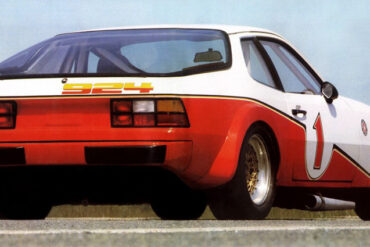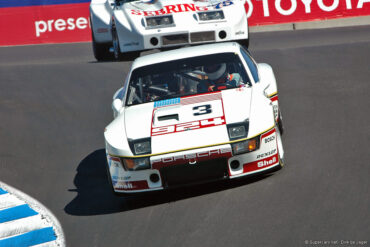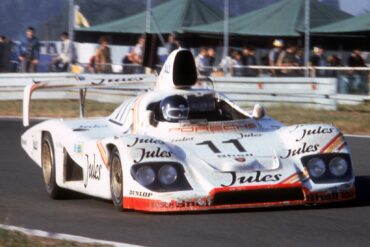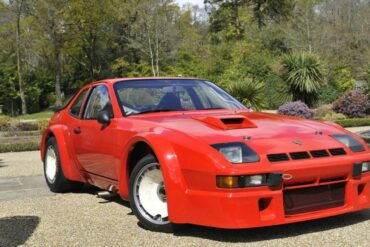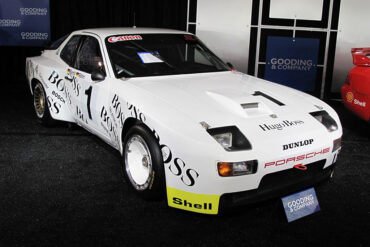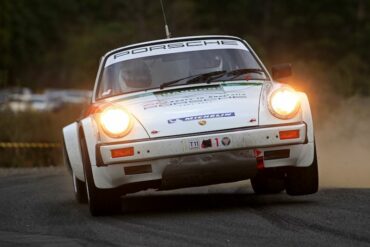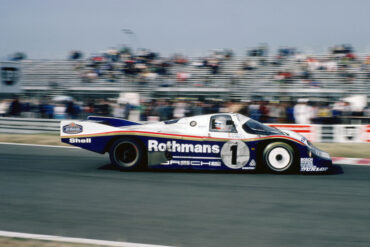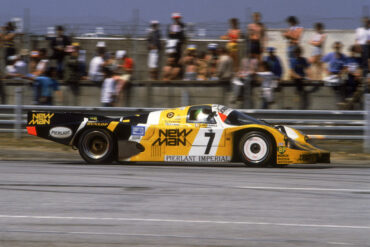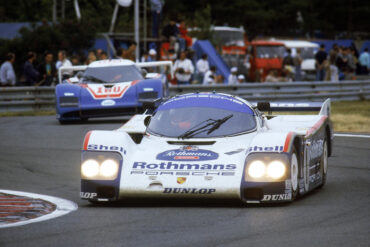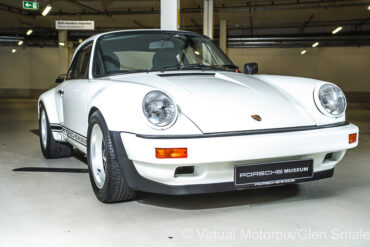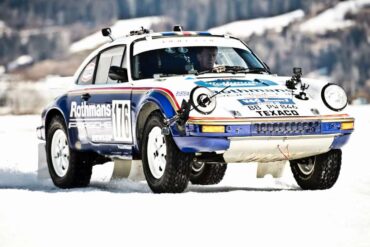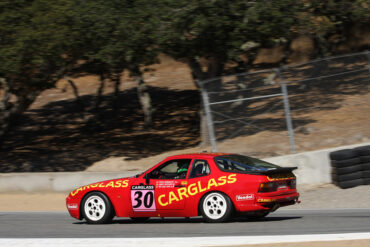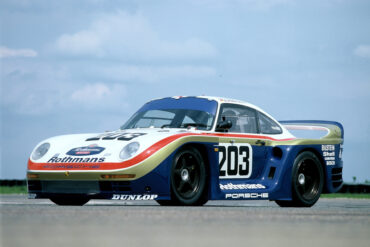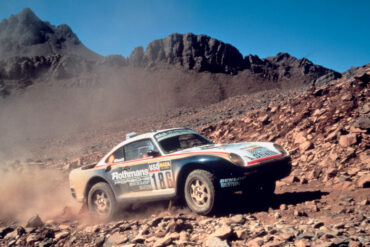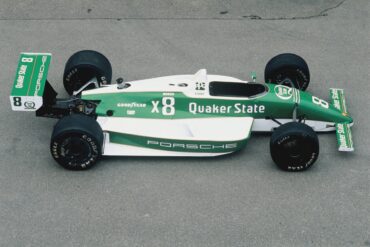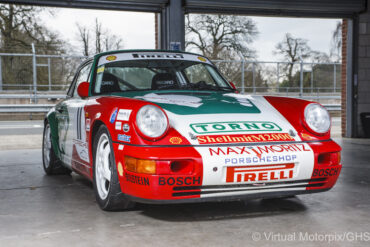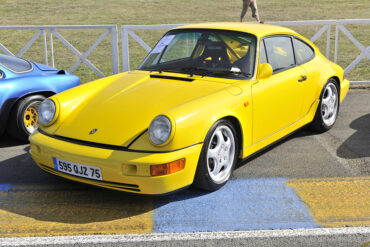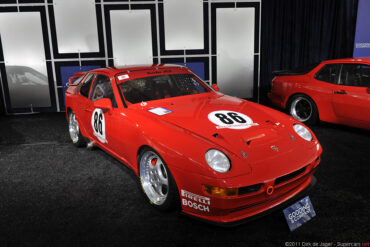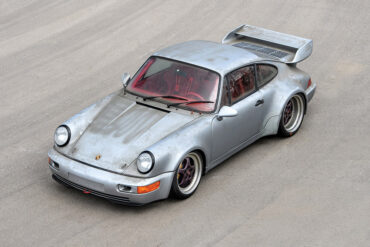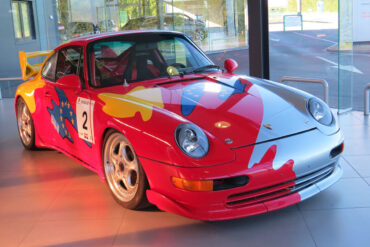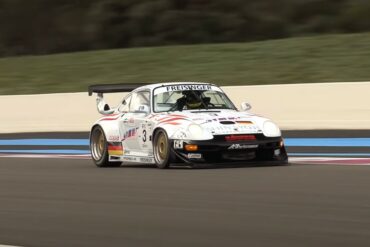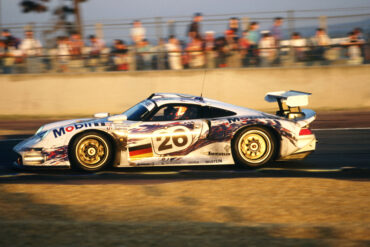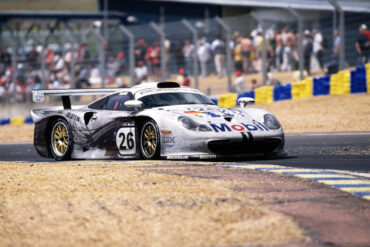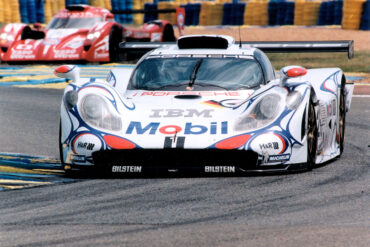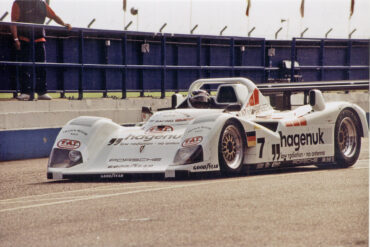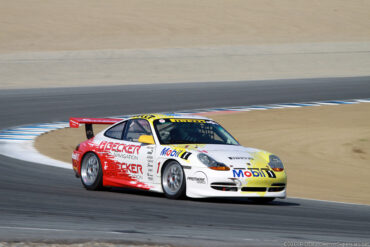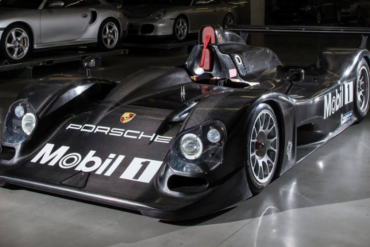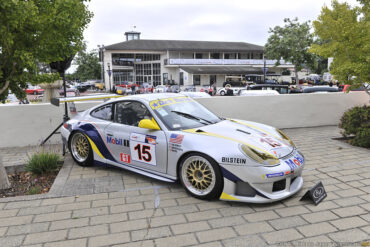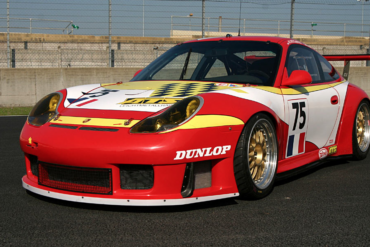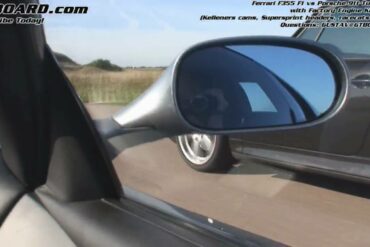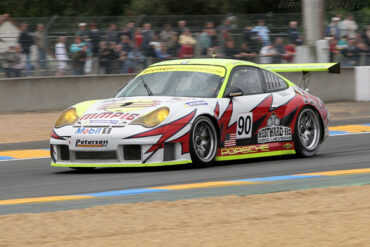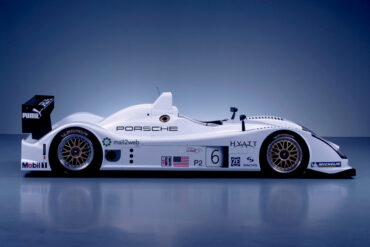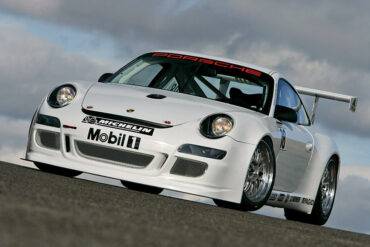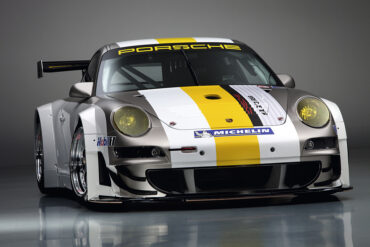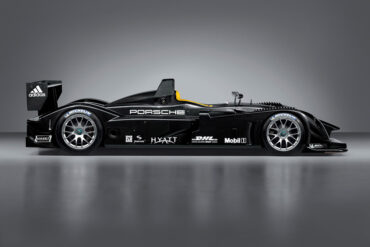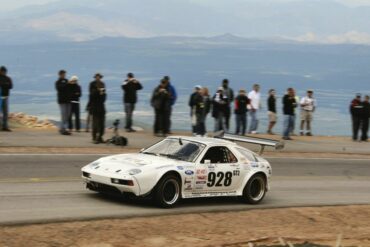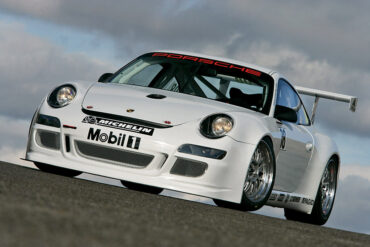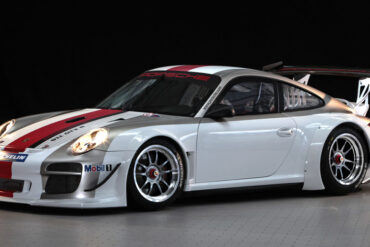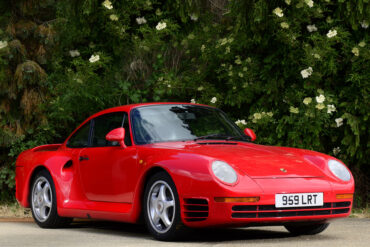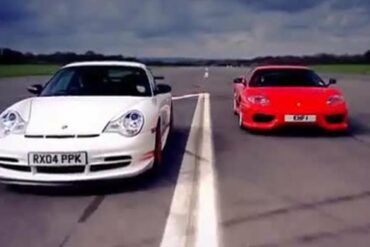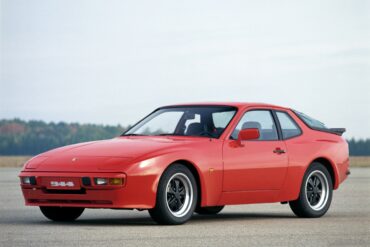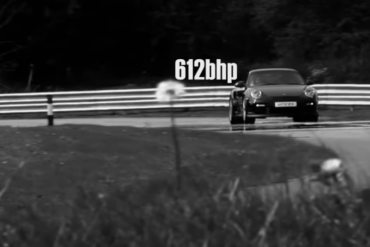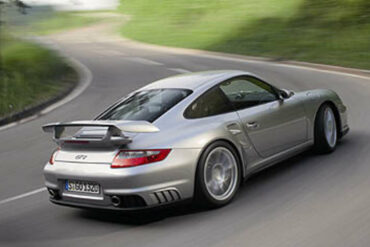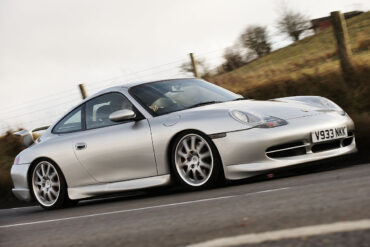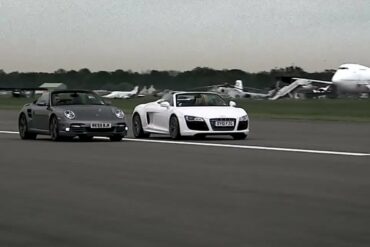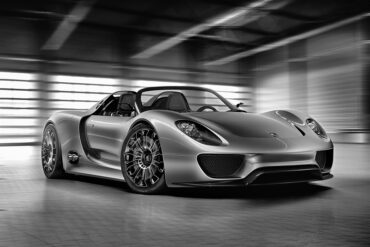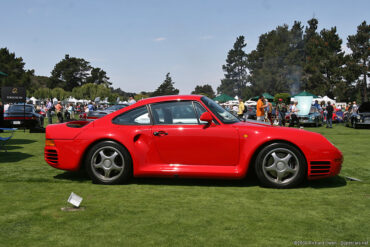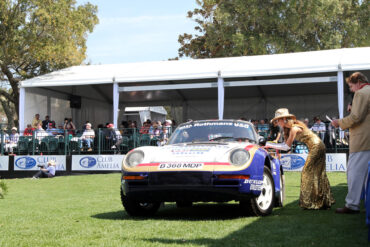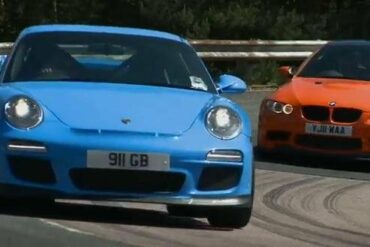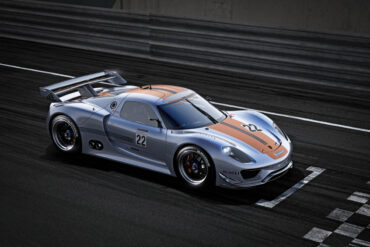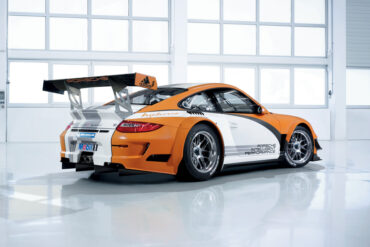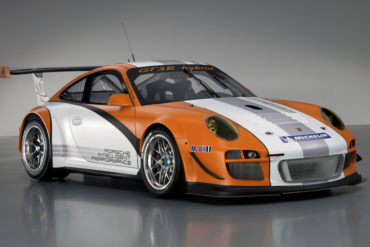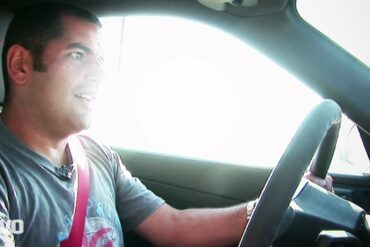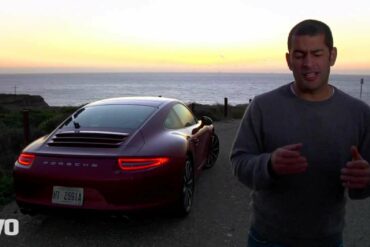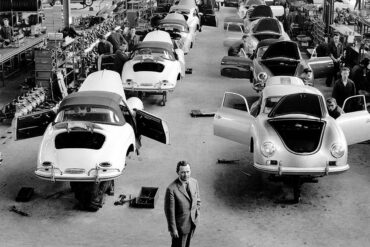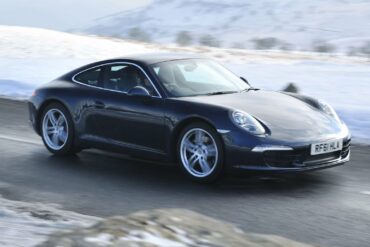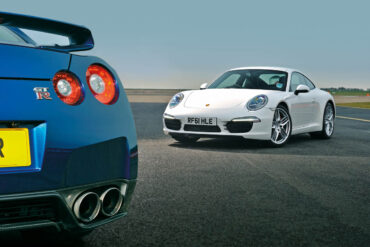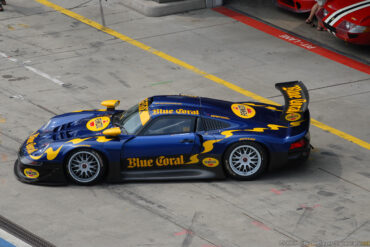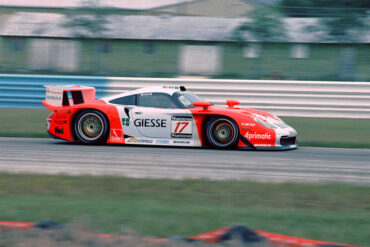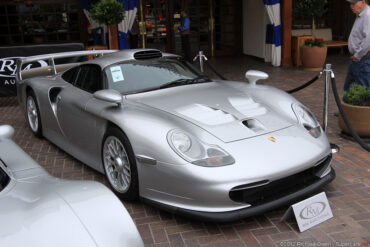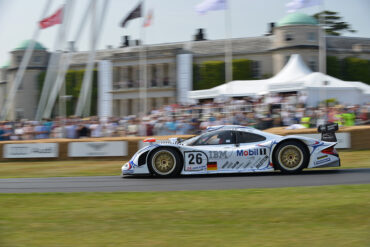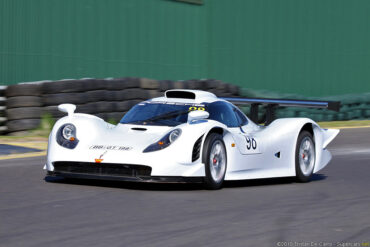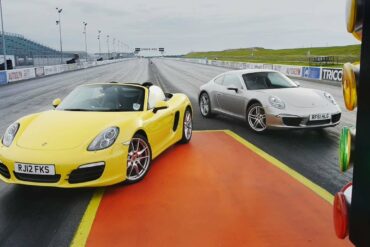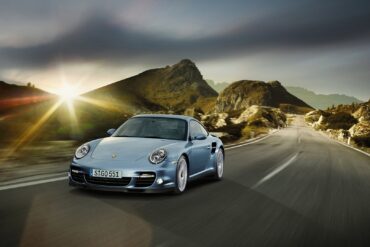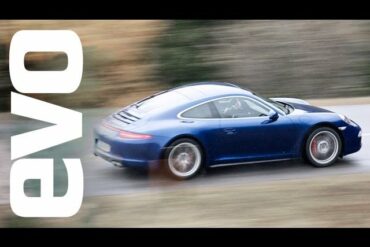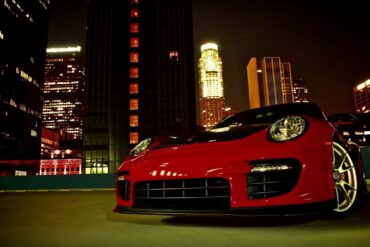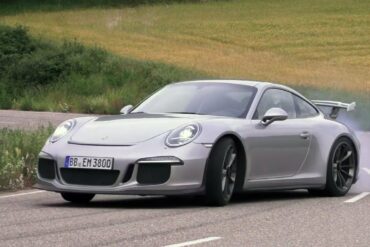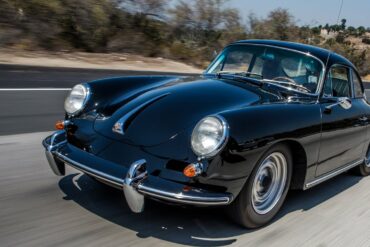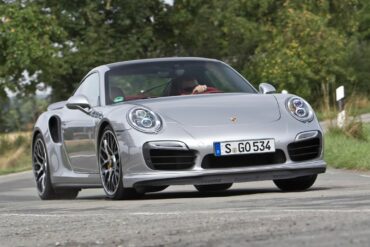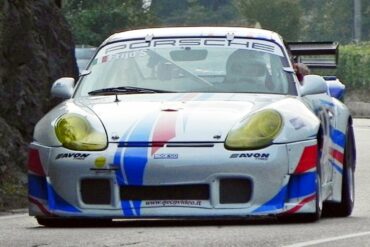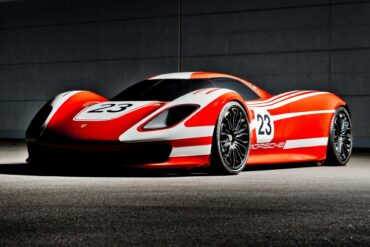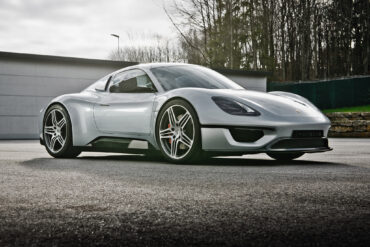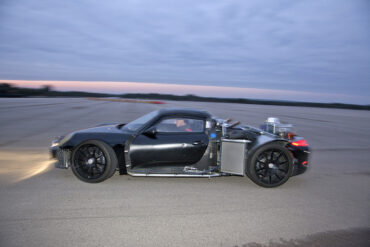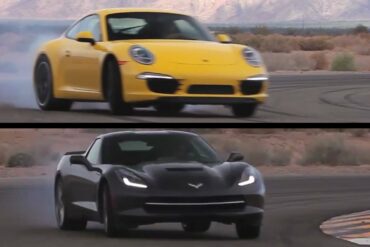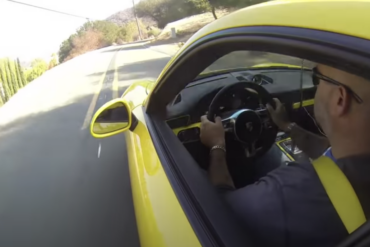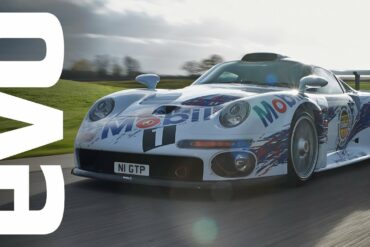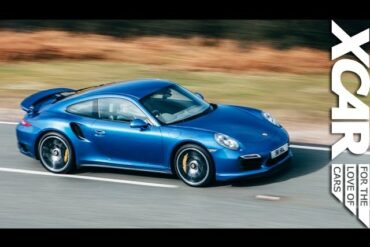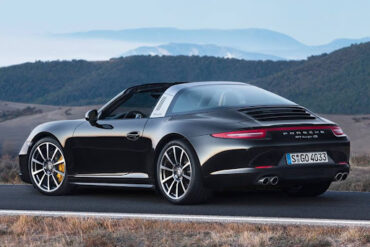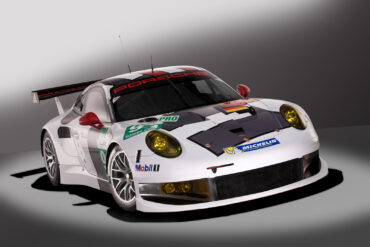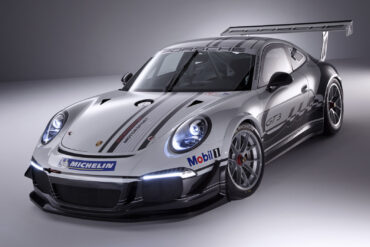The 935/78 was the ultimate expression of the 911 factory race car before Porsche officially withdrew from motor sport. Raced under the Group 5 silhouette series, great liberties were taken with the design and the result was nicknamed ‘Moby Dick’ for its large size and huge overhangs. The 935/78 was built under Porsche's Chief Racing by Norbert Singer for high speeds at Le Mans. Due to the advanced shape of the car 227 mph or 366 km/h was possible.
Porsche Models
All
- Porsche Cayman 987 (2nd Gen)
- Porsche 924
- Porsche Cayenne 955 (1st Gen)
- Porsche Cayenne
- Porsche Carrera GT
- Porsche Boxster Concept
- Porsche 911
- Porsche 959
- Porsche 944
- Porsche 928
- Porsche 962
- Porsche RS Spyder
- Porsche 917K
- Porsche 914
- Porsche 918
- Porsche Cayman 981 (3rd Gen)
- Porsche Cayenne 957 (1st Gen)
- Porsche Boxster 986 (1st Gen)
- Porsche Boxster 987 (2nd Gen)
- Porsche 718 Cayman 982 (4th Gen)
- Porsche Cayenne 958 (2nd Gen)
- Porsche 356 Pre-A
- Porsche Boxster 981 (3rd Gen)
- Porsche 356 A
- Porsche 718 Boxster 982 (4th Gen)
- Porsche 356 B
- Porsche 356 C
- Porsche 968
- Porsche Panamera
- Porsche Panamera 970 (1st Gen)
- Porsche Panamera 971 (2nd Gen)
- Porsche Boxster
- Porsche Cayman
- Porsche Macan
- Porsche Taycan
- Porsche 912
- Porsche 919
- Porsche 956
- Porsche 2708 Indy
- Porsche Type 64
- Porsche 918 RSR Concept
- Porsche 918 Spyder
- Porsche 918 Concept
- Porsche 918 Spyder Prototype
- Porsche 917
- Porsche Race Cars
- 911 Carrera RS 2.7
- Porsche 550
- Porsche 718
- Porsche 901 (911)
- Porsche Concept Cars
- Porsche 904
- Porsche 906
- Porsche 907
- Porsche 908
- Porsche 910
- Porsche 911 (F-Series)
- Porsche 911 (991)
- Porsche 911 (G-Series)
- Porsche 911 (964)
- Porsche 911 (993)
- Porsche 911 GT1 Race
- Porsche 911 GT1 Street
- Porsche 911 (996)
- Porsche 911 (997)
- Porsche 916
- Porsche 919 Hybrid
- Porsche 934
- Porsche 934/5
- Porsche 935
- Porsche 936
- Porsche Mission E
- Porsche 928
- Porsche 928 S
- Porsche 928 S4
- Porsche 928 GT
- 911 Speedster Concept
- Porsche 928 GTS
- Porsche 928 Specials
- Porsche 928 H50
- Porsche 935 Tribute
- Porsche 928 CS/SE
- Porsche 597
- Porsche Mission E Cross Turismo
- Porsche 551
- Porsche Concept 917
- Porsche 911 (992)
- Porsche Sport Tourer Electric
- Porsche Le Mans Living Legend
- Porsche 960 Turismo Concept
- Porsche 919 Street
- Porsche 904 Living Legend
- Porsche 906 Living Legend
- Porsche 911 Vision Safari Concept
- Porsche Bergspyder Concept
- Porsche Macan Vision Safari
- Porsche Vision 916
- Porsche Vision 918 RS
- Porsche Vision 920
- Porsche Vision E
- Porsche 917 16-Cylinder Prototype
- Porsche 959 Gruppe B
- Porsche Carrera GT Concept
- Porsche Tapiro Concept
- 718 Cayman GT4 Rallye
- Porsche Taycan 4S
- Porsche Taycan Turbo
- Porsche Taycan Turbo S
- Porsche Typ 360
- Porsche 645 Spyder
- Porsche 550 Coupé (Prototype)
- Porsche 550 Spyder (Prototype)
- Porsche 550 Spyder
- Porsche 550 RS Spyder
- Porsche 550A RS Spyder
- Porsche 787 F1
- Porsche 804 F1
- Porsche 904 Carrera GTS
- Porsche 904/6 Carrera GTS
- Porsche 904/8 Carrera GTS
- Porsche 904 Bergspyder
- Porsche 906 Spyder
- Porsche 906 LH Coupé
- Porsche 965 (911)
- Porsche 942
- Porsche 906 E Carrera 6
- Porsche 959 Prototype
- Porsche 906/8 Coupé
- Porsche 969
- Porsche 906 Carrera 6
- Porsche 989
- Porsche 910 Bergspyder
- Porsche 910 Targa
- Porsche 909
- Porsche C88
- Porsche Panamericana
- Porsche 718 RSK Spyder
- Porsche 718 RS 60 Spyder
- Porsche 718 RS 61 Spyder
- Porsche 718 W-RS Spyder
- Porsche 718 GTR Coupe
- Porsche 718/2 F2
- Porsche 718 RS 61 LM Coupé
- Porsche 718 RSK Mittellenker
- Porsche 907 K
- Porsche 907 LH
- Porsche 908/01 LH Coupé
- Porsche 908/01 K Coupé
- Porsche 908/02 K Spyder
- Porsche 908 K Flunder Spyder
- Porsche 908 LH Flunder Spyder
- Porsche 908/03 Spyder
- Porsche 908/03 Spyder Turbo
- Porsche 919 Hybrid Evo
- Porsche LMP2000
- Porsche 984
- Porsche LMP1-98
- Porsche 961
- Porsche 917 LH-69
- Porsche WSC-95
- Porsche 917 K-69
- Porsche 917 ‘Interserie Spyder’
- Porsche 917 K-70
- Porsche 917 K-71
- Porsche 917 LH-70
- Porsche 917 LH-71
- Porsche 917/20
- Porsche 917/10-71
- Porsche 917/10-72
- Porsche 917/10 Turbo
- Porsche 917/20 Turbo
- Porsche 917/30
- Porsche 914/4 (1.7 L)
- Porsche 914/4 (2.0 L)
- Porsche 914/6 (2.0 L)
- Porsche 914 LE
- Porsche 914/4 (1.8 L)
- Porsche 914/8
- Porsche 914-6 GT
- Porsche 924 (Base)
- Porsche 924 Turbo
- Porsche 924 Carrera GT
- Porsche 924 Carrera GTR
- Porsche 924 Carrera GTS
- Porsche 924S
- Porsche 924 Rallye Turbo
- Porsche 924 Carrera GTP
- Porsche 924 SCCA
- Porsche 944 Coupe
- Porsche 944 S Coupe
- Porsche 944 S2 Coupe
- Porsche 944 S2 Cabriolet
- Porsche 944 Turbo Coupe
- Porsche 944 Turbo S Coupe
- Porsche 944 Turbo Cup
- Porsche 944 Turbo Cabriolet
- Porsche 944 GTP
- Porsche 944 Swiss Special
- Porsche 944 French Special
- Porsche 944 Celebration
- Porsche 944 S2SE
- Porsche 968 Coupe
- Porsche 968 Cabriolet
- Porsche 968 CS Coupe
- Porsche 968 Turbo S
- Porsche 968 Turbo RS
- Porsche 968 Sport
- Porsche 959 Rally
- Porsche 959 Komfort
- Porsche Cayenne 9YA (3rd Gen)
- Porsche 959 Sport
- Porsche Boxster (Base)
- Porsche Boxster S
- Porsche Boxster S Special Edition
- Porsche Boxster Spyder
- Porsche Boxster RS 60 Spyder
- Porsche Boxster GTS
- Porsche Boxster T
- Porsche Cayman (Base)
- Porsche Cayman S
- Porsche Cayman GTS
- Porsche Cayman GT4
- Porsche Panamera Sport Turismo
- Porsche Cayman R
- Porsche Macan 95B (1st Gen)
- Porsche Cayman S Black Edition
- Porsche Macan (Base)
- Porsche Cayman S Sport
- Porsche Macan S
- Porsche Cayman S Design Edition 1
- Porsche Macan GTS
- Porsche Cayman T
- Porsche Macan Turbo
- Porsche Taycan (Base)
- Porsche Cayman GT4 Clubsport
- Porsche Taycan 4
- Porsche 718 Boxster 25
- Porsche Formula E
- 964 Carrera 2
- 964 Carrera 4
- ’30 Jahre’ Anniversary
- 964 Speedster
- 964 Turbo
- 964 Carrera RS
- 964 Carrera Cup
- 964 RSR
- Porsche Cayman GT4 RS
- 993 Carrera
- 993 Carrera 4
- 911 Edition 50
- 911 2.0 Bertone Roadster
- 993 Carrera 4S
- Porsche Macan T
- Porsche Mission R Electric
- 993 Carrera S
- 993 Targa
- Porsche Vision Gran Turismo
- 992 Sport Classic
- 993 Turbo
- 993 Carrera RS
- 996 Carrera
- 993 GT2
- 996 Carrera 4
- 992 America Edition 911
- 993 Carrera Cup
- 996 Targa
- 996 Carrera 4S
- Porsche 963
- 996 Turbo
- Porsche 718 Cayman GT4 ePerformance
- 996 Turbo S
- 996 GT3
- 996 GT3 RS
- 996 GT2
- 718 Boxster
- 996 GT3 Cup
- 996 GT3 R
- 996 GT3 RSR
- 997 Carrera
- 996 GT3 RS Race
- Porsche 991 (991)
- 997 Carrera S
- 997 Carrera 4
- 997 Carrera 4S
- 997 Targa
- 911 Carrera 3.0 Coupe (G-Series)
- 997 Targa 4S
- 997 Turbo
- 997 Turbo S
- 997 GT2
- 992 Carrera T
- 997 GT2 RS
- 997 Speedster
- 997 Carrera GTS
- 992 Dakar
- 997 Carrera 4 GTS
- 997 GT3 Cup
- 997 GT3 R
- 997 GT3 RSR
- 997 GT3
- 997 GT3 RS
- 997 GT3 R Hybrid
- 991 Carrera
- 991 Carrera 4
- 991 Carrera S
- 991 Carrera 4S
- Porsche 981
- Porsche Vision 357
- 991 Targa 4
- 991 Targa 4S
- 991 Turbo
- 991 Turbo S
- 991 Carrera GTS
- 991 Carrera 4 GTS
- 991 Targa 4 GTS
- Porsche 961
- 991 911 R
- 991 GT3
- Porsche 992 GT2 RS
- 991 GT3 RS
- 991 GT2 RS
- 991 Speedster
- 991 GT3 R
- 991 GT3 Cup
- 991 RSR
- Porsche 962
- 991 Carrera T
- Porsche Cayenne (4th gen)
- 992 Carrera 2
- 992 Carrera 4
- Porsche Type 540 America Roadster
- Porsche 718 Spyder RS
- 992 Carrera S
- 992 Carrera 4S
- 992 Targa 4
- 992 RSR
- 992 Targa 4S
- Porsche Mission X
- 992 Carrera GTS
- 992 Carrera 4 GTS
- 992 Targa 4 GTS
- Porsche RS60 Spyder
- 992 Turbo
- 992 GT3 R
- 992 Turbo S
- 992 GT3
- 992 911 S/T
- 992 GT3 Touring
- 911 (G-Series)
- 992 GT3 RS
- 992 GT2 RS
- 911 Carrera 3.0 (G-Series)
- 992 GT3 Cup
- Porsche Taycan GTS
- Porsche 356 SC
- 911 S (G-Series)
- Porsche Mission X
- 911 SC (G-Series)
- Porsche 992 GT3 R Rennsport
- 911 Carrera RSR 2.8
- 911 S/T
- 911 (Base Model)
- 911 Carrera 3.2 (G-Series)
- 911 SC Safari
- 911 L
- 911 Turbo (930)
- 911 T
- 911 Carrera RSR Turbo 2.1
- 911 Carrera RSR 3.0
- 911 E
- 911 SC San Remo
- 911 S
- Pre-A Speedster
- 911 R
- Porsche 953
- Porsche 356
- 911 Carrera 3.2 Clubsport
- Porsche Panamera (3rd gen)
- 911 SC RS
- 911 Carrera 25th Anniversary
- 911 T/R
- 911 Turbo LE
- 911 Carrera RS 3.0
- Beutler Coupe
- 911 Turbo 2.7
- 911 Carrera 2.7 (G-Series)
- 911 3.2 Speedster
- 911 Carrera Commemorative
- Porsche 911 GT1
- Porsche 99X Electric
- Porsche Macan 4
- 964 Turbo S
- Taycan Turbo GT
In 1978, the works team fields two 911 SC at the East African Safari Rally. The name of game is to survive 5,000 kilometres of the toughest tracks in sweltering heat and torrential rain. The conditions take their toll: of the 72 starters, 13 reach the finish line. Martini Racing Porsche System Engineering signs on two specialists to drive: Sweden’s Björn Waldegård (Start No. 5) and Kenyan Vic Preston Jnr (Start No. 14).
As a top-secret project, the Porsche Museum workshop and the Porsche Heritage department worked on a special front-engined sports car from 1981. 40 years ago, starting on May 15, this car competed in the Deutsche Rallye-Meisterschaft (German Rally Championship). Behind the wheel was non other than Walter Röhrl, with Christian Geistdörfer next to him.
These cars were designed by the factory to race in SCCA D Production Championship starting in 1979. The Porsche project number of these race cars was 933. Only 16 were built by the factory. However, if you had the right connections, you "could" buy the parts as a kit from Porsche to convert your street car into a fully race-ready 924.
GTP cars were produced in 1980, three of which were special LeMans race cars. The cars had the 2.0L turbocharged 924 engine with a huge front-mounted intercooler and increased boost to increase output to 320 HP and 285 lbs/ft of torque. The engine used Bosch mechanical fuel injection and with a weight of 2050 pounds had a top speed of 180 mph. It was third in the GTP class, with an 6th place finish overall, and another finished fifth in class and 12th overall.
Because the traditional pre-test is cancelled in 1981, Porsche is forced to start at Le Mans without testing. None the less, the race ends successfully: Jacky Ickx and Derek Bell win almost an hour ahead of the second placed competitor – right in time for the 50th anniversary of Dr. Ing. h.c. F. Porsche AG, and 30 years after Porsche’s first start at Le Mans.
The Carrera GTR was the ultimate 924 Street/Race Car in 1981. The GTR had larger flares, larger wheels and tires, improved brakes and a whopping 375 horsepower from the 2.0L turbocharged dry-sump engine. At $75,000, the GTR would have cost over $200,000 in today’s money, but what you got was a 180 mph screamer for the street, but in full race trim.
In 1981 Porsche developed two 944 prototypes to succeed the 924 GTPs which raced the 1980 24 Hours of Le Mans. To coincide with the release of the 944 in fall of 1981, Porsche prepared a GTP version to promote the car before the launch. The GTP was equipped with a special Type 949 cylinder block with dry sump lubrication, KKK K28 turbocharger and an air-to-air intercooler.
Röhrl and Geistdörfer very nearly won that San Remo Rally, after a comeback that would have been one for the ages. Röhrl and Geistdörfer were up against a field of faster, more powerful four-wheel-drive cars in their rear-wheel-drive Porsche 911 SC, and somehow managed to pull within an eyelash of victory. Unfortunately, a broken driveshaft forced the pair to retire, leaving Michele Mouton's Audi Quattro to run away with the race.
The Porsche 956 was a Group C sports-prototype racing car designed by Norbert Singer and built by Porsche in 1982 for the FIA World Sportscar Championship. It was later upgraded to the 956B in 1984. In 1983, driven by Stefan Bellof, this car established a record that would stand for 35 years, lapping the famed 20.832 km (12.93 mi) Nürburgring Nordschleife in 6:11.13 during qualifying for the 1000 km Sports Car race.
In 1984 Porsche offered a full works-specification car known as the 956B. This provided the New-Man Joest Racing team with a winning formula and they dominated the 1985 24 Hours of Le Mans with a resounding victory. One of the main differences between the customer 956 and the 956B was the Bosch Motronic engine management. This allowed more precise ignition and injection which in turn provided better economy and more power.
The Porsche 962 arrived on scene in 1984 as essentially a Porsche 956 for the IMSA/US market. A biturbo version was used in competition racing in Europe, while an IMSA version with a turbocharger featured in North America. The 962 C was based on the 956, with a 120 millimetre longer wheelbase and competed in LeMans. It differed from the IMSA version. The driver trio Stuck/Bell/Holbert was victorious at Le Mans in 1987. Porsche offered the 962 to privateers to race on their own and they were hugely successful.
Built so that the factory Rothmans Porsche Rally Team could hit the international stage, the SC RS used the Turbo’s body with fibreglass bumpers and aluminium doors. In Autumn 1983, Porsche presents the 911 SC/RS for motor racing. The engine originates from the 911 SC, with improved performance achieved by the mechanical ball fuel injection, increased compression, the cylinder heads from the 935 and forged pistons. Racing seats are fitted in place of the standard seats.
The Porsche 953 ranks as one of the finest off-roaders Porsche has ever made. It was basically a souped-up 911 designed specially to give Porsche an advantage in the 1984 Paris–Dakar Rally. Just a year later, it was replaced by the 959. Despite its brief run, it still managed to make quite the impression. Built around a massively enhanced suspension and a supremely powerful 300 bhp (224 kW), 6-cylinder engine, it showed Porsche knew more than just sportscars.
In late 1985 Porsche developed the 944 “Weissach turbo cup race car” to provide amateur enthusiasts with a cost effective entry into motorsports. Porsche initially designed to participate in a single-marque racing series run in conjunction with 1986 German ADAC Supercup races, but soon spread to Italy, Spain, Belgium, Austria , USA, Canada and even Czechoslovakia. The cars were modified extensively for racing duties, including taking out a lot of weight.
The Porsche 961 was the racing version of the 959 supercar. While the 959 rallye car was also internally called 961, publicly only the circuit racer was called 961. Only one 961 was built. It had 959 prototype chassis number which in turn was from the 1985 911 Turbo chassis number sequence: WP0ZZZ93ZFS010016. The 961 was entered at the 1986 Le Mans 24 hour race. Uncommonly, the 24 hour race was scheduled for May 31-June 1 that year, two weeks earlier of the typical Le Mans weekend in the middle of June.
The 959 took both first and second place in the 1986 Paris-Dakar rally. For 1986, the Dakar Porsches finally got all the upgrades from the 959 project, including the active four-wheel drive system offering four driving modes adjusted by the computers. This gave Porsche a 1-2 finish, with supporting 959 Dakar engineer Unger Kussmaul crossing the line at sixth. Once the champagne had dried up, Porsche deemed its Dakar program accomplished.
Porsche again attempted to enter CART in 1987. This time it would be a full factory effort, chassis and all. The car had an aluminum-plastic monocoque chassis attached to a 2.6 Liter, 800hp V8. Information gained from their 1980 bid would be used to build the car. This was their first mistake. Indy had stepped up their game over that seven year span. The pole speed at Indy had advanced from 192 mph in 1980 to 215 mph in 1987. It was a different world.
Introduced in 1989 (the year of the 911’s 25th anniversary), the 964 Carrera 4 was a significant new model for the company, but the 4-wheel drive system was deemed unsuitable for the company’s racing series. Manufactured alongside the Carrera 4 at the same time was the more traditional rear-wheel drive Carrera 2, but this model’s launch was only planned for a year later, in the hope that it would not detract from potential sales of the Carrera 4. The 1990 season was the first season that saw the 911-based model become the pillar on which the Porsche Carrera Cup series has been established.
For race teams and track day customers Porsche prepared a small number of the 964 Cup cars according to the FIA NG-T regulations. Officially called the Competition model, these custom-ordered cars were an intermediary step between the Carrera Cup option (M001) and the standard tourer (M002). This M0003 option was available directly from Porsche as a road-going model. These cars had almost all the Carrera Cup modifications including the new suspension. This lowered the car by 40mm in the rear and 50mm in the front. It also included fitting of the larger 930 Turbo disc brakes and adjustable anti-roll bars.
In 1992, Porsche introduced the 968 Turbo RS racecar which it developed to compete in the new ADAC GT racing series in Germany. The car was based on the 968 coupe with limited lightening due to the regulations of the series which had a 4kg/bhp power/weight ratio limit. The car featured a K27 turbo boosting the 3.0 litre, 4 cylinder engine and an 8V head, similar to the 944 Turbo S, rather than using the 16V 968 head.
With the 1993 Carrera 2 as the starting point, Porsche had to make at least 50 roadgoing cars in order to qualify this new model for the Carrera ADAC GT Cup, which served as the basis for a motor racing variant to come, the Carrera RSR 3.8. The RSR 3.8 was nothing short of an all-out race car that could be delivered to the track in a ‘just add driver’ form. The Porsche Carrera RSR 3.8 racked up a catalogue of impressive international race results right from the outset, winning overall at the Spa 24 Hours, Suzuka 1000km, and the 24 Hours of Interlagos.
The 993 Carrera Cup 3.8 was developed from the 993 Carrera RS, as purpose-built competition car designed by Porsche for its single-model racing series taking place around the world. Replacing the 964 Carrera Cup, the 993 Carrera Cup had a claimed 315 bhp on tap, weighed only 1,100kg, and offered a top speed of around 270km/h (170mph). Approximately 216 samples were built. The Carrera Cup should not be confused witth the Carrera RSR, or the 993 Carrera RS Clubsport version.
The racing sportscar is prepared by Porsche following the Le Mans GT2 regulations for the over 1,150 kg weight classification. It features a 3.6-litre engine with two turbo-chargers (KKK 24 with 33.8 mm restrictors), which delivers around 450 hp at 5,750 rpm. Even this racing vehicle, with its suspension featuring a McPherson front axle and Porsche multi-link rear axle with LSA system, closely resembles its production relative. Utilizing a steel 993 Twin Turbo chassis with modifications for racing, scored numerous victories in a wide variety of racing venues.
In spite of its 911 moniker, the car actually had very little in common with the 911 of the time, only sharing the front and rear headlamps with the production sports car. Designed and developed to compete in the GT1 class of sportscar racing, which also required a street-legal version for homologation purposes. It was powered by a twin-turbo flat 6 that was good for 600 bhp. The 1996 911 GT1 clocked at a top speed of exactly 330 km/h (205 mph) on the legendary Mulsanne Straight.
The 993 Carrera RSR takes the 993 Carrera RS formula and makes it even more track-ready by adding a roll-cage and removing carpet, power windows, and a/c. There were just thirty Porsche 911 Cup 3.8 RSR (Type 993) race cars produced for the 1997 season. This model was the last of the breed of air-cooled, naturally-aspirated 911 race cars to come from the Weissach race department before the introduction of the Type 996 water-cooled cars. To find a 993 3.8 RSR that participated in some of the world’s toughest endurance races in period, and survived unscathed and unmolested, is quite rare.
Towards the end of the 1996 season, Porsche made revisions to the 911 GT1 in preparation for the 1997 season. The front end of the car was revised including new bodywork which featured headlamps that previewed the all-new generation of the (996) Porsche 911 which would be unveiled in 1997. It had the same engine as the previous version, but new aerodynamic elements allowed the 1997 version to be considerably faster than the 1996 version. At Le Mans the works cars led the race but did not last the full distance; a privately entered 1996 specification GT1 managed 5th overall and third in its class.
The 1998 GT1 car was a totally rethink and vast upgrade versus the prior year car. 1998 Le Mans 24-hour race In the 1998 jubilee year, the Porsche team celebrated its 16th overall victory in Le Mans with a double win for the 911 GT1 98. On 6th/7th June, the winning car was driven by Laurent Aiello, Allan McNish and Stéphane Ortelli. It was almost 50 years to the day on which the first Porsche sports car saw the light of day.
The Porsche WSC-95 (sometimes referred to as the TWR WSC-95) was a Le Mans Prototype originally built by Tom Walkinshaw Racing. It was modified by Porsche from the original Group C Jaguar XJR-14 from which it derived,[1] and run by Joest Racing. The WSC-95 saw very little race action even though it won the 24 Hours of Le Mans in both 1996 and 1997 without being acknowledged as a factory supported project. Later upgraded to the Porsche LMP1-98 before being retired. Only two cars were ever built.
The 996 GT3 Cup served as the basis for the 996 GT3 road car, featuring a 3.6 litre engine with 355 hp. For the 1999 season the engine output was increased to 365 hp. For the 2001 season the GT3 Cup received modified aerodynamics including an enlarged rear wing and improved cooling. For 2002, the GT3 Cup received several changes, adopting facelift 996.2 features such as Turbo-style headlights. The new body significantly improves aerodynamics and cooling. Engine output was increased to 380 hp. For 20003 onward, the power was hiked once again, with the engine now pumping out 385 bhp @ 7250 rpm and of torque 288 ft lbs @ 6500 rpm.
The Porsche LMP2000 (also known as the Porsche 9R3) is a Le Mans Prototype racing car that was developed between 1998 and 2000, but never raced. One car was built, and it was designed around a modified version of Porsche's 3.5-litre V10 engine that was originally designed for Formula 1 in 1992. The project was canceled before the car was built, leading to various rumors about the reason for its demise.
The 996 GT3 R was a one-year-only (2000 model year) special of which only 63 were produced. The car took the basic GT3 bones and amplified it for motorsport. The Mezger engine produced over 400 horsepower, while factory-fitted adjustable shock absorbers gave better handling. Most notably, the GT3 R wore carbon-fiber bodywork meant for ultimate light weight in motorsport. The 996 GT3 R was introduced in 1999 as a replacement for the 993 RSR. Before its introduction, it was extensively tested at Weissach and Paul Ricard. In the 2000 FIA GT Championship, the 996 GT3 R was in the N-GT class and won every run. Won the 24-hour race at the Nürburgring.
In the 2000 FIA GT Championship, the 996 GT3 R was the dominant racer in the new N-GT class and won every run. In the same year, the factory-supported Phoenix Racing won the 24-hour race at the Nürburgring. In 2001, the modified version, now called the 996 GT3 RS, was used. The vehicle was not only very successful in its class, it also achieved overall victories. Modelled on the 911 GT3 R, the GT3 RS race cars offered a number of technical improvements, which combine to ensure a racing car with optimal competitiveness. 50 racing cars were produced.
Ferrari F355 vs Porsche 911 Turbo (993) Ferrari F355 F1 vs Porsche 911 Turbo (993) with Engine Kit 430 HP...
Based on the road-going 996 911 GT3 RS, the GT3 RSR features improvements to its predecessor in all key areas. The vehicle is available in an ACO (Automobile Club de l'Ouest) version for competing in Le Mans and in the American Le Mans Series as well as in a FIA specification. The 911 GT3 RSR features a modified front which improves downforce at the front axle. The 3.6-litre, six-cylinder boxer engine delivers 445 hp at 8,250 revs. Maximum torque is now 405 Nm at 7,200 rpm, with top revs reached at 8,500 (for the FIA specification with two 30.8 mm air restrictors). Race cars never got more exciting than this.
The Porsche RS Spyder, internally called 9R6, exists only thanks to a customer order made in 2004 by Penske Motorsports, a subsidiary of Penske Racing. The 9R6 was built according to the Le Mans Prototype class 2 (LM P2) regulations and to be raced at the American Le Mans Series (ALMS) in USA and Canada. The ALMS was created in the spirit of the Le Mans endurance races, hence the name of the series.
The Porsche 997 GT3 Cup was a series of race cars created by Porsche to enter the Fédération Internationale de l’Automobile (FIA) Group GT3 racing class. Replacing the 996 GT3 Cup, the 997 Cup's 3.6 litre engine is rated at 294 kW (400 PS; 394 hp) and was mated to a six-speed sequential transmission. In 2009, the GT3 Cup received several 997.2 updates including a new 3.8 litre engine with an output of 331 kW (450 PS; 444 hp).
Porsche has announced the introduction of the new 2007 911 GT3 RSR (type 997) for the American Le Mans Series and other world GT racing venues. The latest version of the most successful racing sports car in history is based on the street production model 911 GT3 RS (model year 2007) and was launched in late 2006. The 911 GT3 RSR has wider rear fenders and rear track to improve performance capabilities over its predecessor. The car has also been developed to fit into the 1,225 kg class. The new car is built in accordance with the ACO LMGT2 Regulations and the FIA Article 257.
Following a development year with Penske Motorsports in ALMS, Porsche revealed the final version of their LMP2 contender for the 2007 season. Known as the 'EVO' model, it had a host of upgrades that made it suitable for customer-funded teams to successfully compete. This model dominated the P2 class at events like Le Mans and Sebring. It raced from 2007 till 2010 with strong results across the board.
In 2007, 2008 and 2009 American racing driver Carl Fausett took his specially prepared and supercharged 1978 Porsche 928 to the Pikes Peak International Hill Climb and competed in the Open Division. Fausett placed third in the Open Division in both 2007 and again in 2009, where he was also the fastest 2WD car. At that time, much of the race course was gravel.
To a large extent, the 3.6-litre boxer engine is identical to the power unit used in the Porsche Mobil1 Supercup and the international Carrera Cup championships. Power output has increased by 20 horsepower to now 440 hp (324 kW) at 8,000 rpm. Maximum torque is up by ten Nm to 430 at 7,250 revs per minute. The power increase results from optimised engine electronics and a modified exhaust system. In contrast to the GT3 Cup, the body of the Cup S is not based on the road-going GT3 but on the GT3 RS.
Following the Porsche 911 GT3 Cup, Porsche AG, Stuttgart, is entering yet another racing car in the 2010 motorsport season: The 911 GT3 R will be raced in series based on the international FIA GT3 regulations, thus succeeding the 911 GT3 Cup S. The main focus in developing this new model was on even better drivability and even easier handling. The 911 GT3 R is powered by a four-litre six-cylinder boxer engine delivering maximum output of 480 bhp (353 kW) transmitted to the rear axle by a sequential six-speed dog gearbox.
Porsche 959 Wallpaper Collection We have curated the ultimate collection of the best Porsche 959 Wallpapers and HD backgrounds for...
Clarkson Spanks the Porsche 996 GT3 RS vs Ferrari 360 Track days with Jeremy Clarkson and the Porsche GT3 RS...
The base Porsche 944 coupe was built between 1982 and 1989, essentially the same platform as the Porsche 924 (there was some overlap as the 924 was produced till 1988). The 944 was intended to last into the 1990s, but major revisions planned for a 944 S3 model were eventually rolled into the Porsche 968 instead, which replaced the 944.
Auto Express Reviews The 997 Porsche 911 GT2 RS The 911 GT2 RS is the fastest and most powerful production...
The 997 GT2 RS Is the Fastest Stick-Shift Production Porsche Ever Chris Harris drives the all new 911 GT2....
Porsche 911 (996) Technical Specs & Performance Porsche 911 (996) Coupe & Cabriolet Specs Porsche 911 (996) GT Car Specs...
Top Gear Drag Race – Audi R8 vs Porsche 997 Jeremy heads out on to the test track and pits the...
The 918 Spyder concept combines high-tech racing features with electric-mobility to offer a fascinating range of qualities. The highly-innovative 918 Spyder concept car combines Porsche's Intelligent Performance philosophy with the high-technology from motorsport, with classic but modern design to make a truly convincing statement.
Porsche 959 Sport (1987 – 1988) Pictures...
Porsche 959 Rally (1984) Pictures...
Autocar Compares the BMW M3 GTS to the 997 Porsche 911 GT3 Can the hardcore BMW M3 match the legendary...
Made as a demonstrative show-car, the 918 RSR ‘Racing Lab’ was part of a new initiative called Porsche Intelligent Performance which will likely develop hybrid racing cars for outright victories at events like the 24 Hours of Le Mans. The concept version revealed at Detroit has the same visual styling cues as the Spyder released in 2010 with the hybrid drive system from the 911 GT3 R Hybrid.
During the Geneva Motor Show, a Porsche 911 GT3 R with innovative hybrid drive is making its debut. The innovative hybrid technology featured in the car has been developed especially for racing, standing out significantly in its configuration and components from conventional hybrid systems. In this case, electrical front axle drive with two electric motors developing 60 kW each supplements the 480-bhp four-litre flat-six at the rear of the 911 GT3 R Hybrid. Instead of batteries, an electrical flywheel power generator delivers energy to the electric motors.
The Porsche 997 GT3 R Hybrid 2.0 is an update to the 997 GT3 R Hybrid. Compared to its predecessor, which debuted in 2010, the 2011 second-generation hybrid is 20 percent lighter and more efficient without any concession to lap times. While sharing the same paint scheme, the new vehicle is easily identified by its lack of intakes in front of each rear wheel - changes to engine cooling allowed the slats to be dropped and aerodynamic efficiency improved. It gets a traditional race-bred flat six engine. The GT3 R Hybrid has a completely independent second driveline in the front of the chassis, a clever and complex hybrid electric set up that rockets it from standstill to 60 mph in just 2.5 seconds.
2011 Porsche Carrera GTS Review The 2011 Porsche Carrera GTS is the last of the type 997 Porsches before the...
GT3 RS 4.0 RS Ride & Review Chris Harris reviews the evo cars of the year...
Chris Harris Review of the 991 Porsche 911 Chris Harris gets a first look at the new 911 in California....
Last Drive Before Hibernation English winters and Michelin Pilot Sport Cup tires don’t mix, so I’m taking one last drive...
Tuned Porsche 997 Turbo S Review TUNED visits BBi Autosport in Huntington Beach, CA to drive their new Porsche 997...
The world of early Porsche production This footage was taken between late 1959 and late 1961. Great view into the...
Autocar Reviews the New 991.1 Carrera S The new Porsche 911 Carrera S (991) is the most important new sports...
EVO Magazine Reviews the 2012 Base Carrera Richard Meaden gets his hands on the all-new, 991-gen Porsche 911 Carrera in...
Nissan GT-R vs Porsche 911 Carrera S evo’s latest signing, Tiff Needell, puts the 2012 Nissan GT-R and the brand...
1996 Porsche 911 GT1 Pictures & Gallery...
1997 Porsche 911 GT1 Evolution Pictures & Gallery ...
1997 Porsche 911 GT1 Straßenversion Pictures & Gallery...
1998 Porsche 911 GT1-98 Pictures & Gallery...
1998 Porsche 911 GT1 ’98 Straßenversion Pictures & Gallery...
2013 Porsche 911 Carrera S Coupe – WINDING ROAD POV Test Drive Great POV review of the 991.1 Carrera S....
991 Carrera vs. Boxster S The Porsche Boxster S has always been considered the poor man’s Porsche, though the latest...
Porsche 911 (997) Technical Specs & Performance Porsche 911 (997) Production Car Specs Looking at the tables above, the conclusion...
Henry Catchpole Drives the new 991 Carrera 4S evo’s Henry Catchpole takes the new 991 Carrera 4S, the latest four-wheel-drive...
Porsche 911 GT2 RS Top Gear Review The team takes the Porsche 911 GT2 RS around the closed streets of...
Chris Harris Spanks the New 991 GT3 If we were a car magazine we’d call this a WORLD EXCLUSIVE, but...
Carfection Reviews the New 991.2 Carrera S A new 911 is always something to pay special attention to. It’s the...
964 911 Turbo Review Tiff is my favorite presenter.. You looks like a silly unassuming British man, then he gets...
Porsche 911 Carrera 4 GTS (997): A Greatest Hits Collection? The GTS variants of the 997 Porsche 911 were regarded...
1963 Porsche 356 Carrera 2. When Jay was lucky enough to acquire what he calls “one of the most beautiful...
A Thorough Review of the 991 GT3 The all-new 991-generation Porsche 911 GT3 faces its toughest challengers on road and...
991 Porsche 911 Turbo S Road Review The 552bhp 991 Porsche 911 Turbo S is supremely fast, but does that...
Porsche 996.1 v 996.2: Every Detail Revealed DRIVETRIBE’s Editor-at-Large introduces his 150,000-mile, 996-generation Porsche 911…...
Top Gear’s Original Review of the 911 Porsche 993 Turbo Needell of Top Gear fame road tests the 911 Porsche...
Turn Up the Volume to the Perfect Flat 6 Screaming Sounds This video is about a couple of Porsche 996...
TheGetawayer Drives A PDK Base Carrera (991) To finish this year’s season of car-reviews, Porsche gave me this beautiful 911...
Porsche 997 911 GT3 Review The 997 GT3 was a tour de force of driving brilliance, treading the balance between...
In 2013, a small team from Weissach developed a tribute to the 1970 Le Mans winner. The concept utilizes adaptive aerodynamics with Salzburg livery like the original. Carbon Fibre skin, carbon fibre Monocoque and a turbocharged eight-cylinder engine with up to 1,000 PS provides the power. The front and rear suspension are based on 918 components, utilizing motorsport-inspired linkages and pushrods.
This concept car was kept in secrecy until 2020. Under the cover there is a Volkswagen XL carbon fibre monocoque chassis and the car could have been powered by a high-revving motorbike engine. The 1:1 hard model of the possible future 904 looks similar to the Porsche 918 supercar from the front and to the F. A. Porsche designed 904 Carrera GTS supercar from the side. It looks just perfect!
Porsche 918 Spyder Prototype is a combo of mis-matched Porsche parts that looks more like a Frankenstein car than a cutting edge technical automotive marvel. But don't let the crazy exterior fool you because underneath, the 918 Spyder Prototyp is a pure science experiment designed to wow us in a few years.
Chris Harris Compares the Corvette C7 v Porsche 991 Carrera S. On Track The Corvette costs the same as the optional...
TheSmokingTire Review of the 991 Porsche 911 Carrera S Matt takes a spirited drive through the canyons in the 2014...
Porsche 911 GT1 – Inside Evo Henry Catchpole recently drove the road-going Porsche 911 GT1 straßenversion at the Porsche Experience...
991.1 Porsche 911 Turbo S Carfection Review We take a look at the all-new 2015 Porsche 911 Turbo S and...
Tiff Needell & A Lovely Targa 4S Tiff Needell reviews the Porsche 911 4S Targa (991), and finds out how...
Fifth Gear Pits The Porsche 911 Carrera S vs BMW M6 Sabine Schmitz joins Tiff in seeing which car is...
As the rules do not permit higher output engines, the engine for the 991 RSR was taken from the 997 GT3 RSR 4.0 and the development work focused on the chassis, body, aerodynamics and the gearbox. A wishbone front suspension replaced the McPherson struts used in 997. A new development was the lightweight gearbox. One of the priorities in the development was the more evenly balanced weight distribution. The centre of gravity was lower, too.
The new Porsche 911 GT3 Cup is powered by a 3.8-litre six-cylinder flat engine. It generates 460 hp (338 kW) at 7,500 revs, surpassing the predecessor by 10 hp. A six-speed dog-type gearbox developed by Porsche Motorsport which is operated via shift paddles at the steering wheel for the first time in a Porsche brand trophy race car transmits the power to the rear axle. The single piece race wheels with centre mount were also new.
991 Carrera 4S v Carrera 2S Track Battle In episode 3 of the evo track battles, Richard Meaden takes the...
Evo Track Battle in a 996 GT3 vs Cayman GTS The all-new Porsche Cayman GTS could be the best sports...


